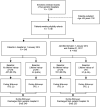Prevalence and incidence of venous thromboembolism in geriatric patients admitted to long-term care hospitals
- PMID: 39085300
- PMCID: PMC11291751
- DOI: 10.1038/s41598-024-67480-1
Prevalence and incidence of venous thromboembolism in geriatric patients admitted to long-term care hospitals
Abstract
The risk of venous thromboembolism (VTE) increases with age. However, the risk of VTE in the setting of long-term care hospitals is understudied. Our objective was to provide data on the prevalence and incidence of VTE in older adults admitted to long-term care hospitals. In this retrospective cohort study, we collected data about chronically ill and multimorbid patients aged 65 years and older from two long-term care hospitals. The primary endpoint of this study was the lifetime prevalence of VTE, and the secondary endpoint was VTE incidence during residency in long-term care hospitals. We analysed data from 1148 patients with a mean age of 84.1 ± 7.9 years, of whom 74.2% were women. The lifetime prevalence of VTE at baseline was 9.6% (95% CI 7.9-11.4). Cumulative incidence of VTE at 1, 2, and 3 years from baseline was estimated at 3.5% (95% CI 2.5-4.7), 4.2% (95% CI 3.1-5.5), and 5.4% (95% CI 4.1-7.0), respectively. Overall, the incidence rate of VTE in our study was 2.82 (95% CI 2.18-3.66) per 100 person-years. The study indicated a considerably high lifetime prevalence and incidence of VTE during residence in long-term care hospital settings, requiring further evaluation in larger prospective studies.
Keywords: Geriatric patients; Long-term care hospital; Oral anticoagulation; Venous thromboembolism.
© 2024. The Author(s).
Conflict of interest statement
GW, DS, CG, DM, SN, GG, and GO have no conflicts of interest. MS received honoraria from Eli Lilly, Novartis, Pfizer, Amgen, Sanofi-Aventis, Roche, and Boehringer. IP received honoraria for lectures and participation in advisory boards from Bayer, and BMS/Pfizer, none had a role in the design of the study. CA received honoraria for lectures and participation in advisory boards from Bayer, BMS/Pfizer, Daiichi-Sankyo and Sanofi. Pfizer Austria had no role in the design of the study; in the collection, analyses, or interpretation of data; in the writing of the manuscript; or in the decision to publish the results.
Figures
References
MeSH terms
LinkOut - more resources
Full Text Sources


